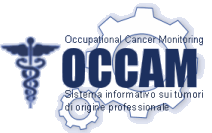- You are: OCCAM / home
Welcome to OCCAM
The OCCAM (OCcupational CAncer Monitoring) project rises from the collaboration between Italian National Istitute Workplace Safety and Prevention ISPESL (Istituto Superiore per la Prevenzione e la Sicurezza sul Lavoro) and Italian National Cancer Institute in Milano (Istituto Nazionale per lo studio e la cura dei tumori) in order to investigate occupational cancer risk by primary site, geograophic area (province, region) and industrial sector. Besides this approach to cancer surveillance, while allowing to identify cases attributable to past occupational exposures, it permits to set priorities for prevention and start legal actions for compensation purposes. OCCAM surveillance approach lies on carrying out case-control studies where occupational histories of cases (cases), obtained with an automatic linkage with social security (INPS) files, are compared with those of healthy people (controls). Cancer cases are drawn from routinely available sources. In the pilot phase of the project this surveillance approach has been tested using incident cases from six Italian Cancer Registries in the period 1990 – 1997 and thereafter cases Hospital Discharge Records (SDO), which are available more quickly and cover almost all Italian areas.
Data on past employment of employees of the private sector are available in electronic form at the National Social Security Institute from 1974. For each year of employment the employing firm, its economic branch and the white collar-blue collar status are available.
To interpret the OCCAM findings and to provide a fast and easy tool to those who are interested in occupational cancer, a “Literature Matrix” has been built. The matrix contains now refernces to 922 scientific papers published from 1976.
The OCCAM (Occupational Cancer Monitoring) project derives from the article n. 71 of the Italian Occupational Safety act the foresee an occupational cancer registry. This act attributes to ISPESL the duty of establish a system for the “occupational cancer monitoring”, with an archive of names of cases likely to be of occupational origin, notified by “practitioners, hospitals and social security institutions. The attention paid from health professionals to the occupational risk, however, has been scarce. Moreover, the difficulty of performing a detailed professional history for many patient is enormous. Therefore, a system based on “spontaneous” notifications is infeasible. In 2000 ISPESL and Istituto Nazionale per lo Studio e la Cura dei Tumori in Milano prepared a project to identify cancer cases attributable to occupational origin by using information available on existing archives.
CASES Cases considered are of both genders, aged 35-69 identified by Cancer Registries or by Hospital Discharge Records with a social security (INPS) occupational history. Subjects aged more than 69 are excluded because too time has elapsed from retirement, whereas cases younger than 35 are excluded as their occupational origin is unlikely considering the too short latency.
CONTROLS Controls are identified by random sampling the case base, i.e. the NHS archives of the same areas the cases come from and of the same(s) calendar year. The random sample is stratified by age (5-years interval) and gender. Sample size has been determined from the number of cases in inverse relationship with age- and gender- case numbers.
SDO
The payment by the NHS to the private and public hospitals is based on the Hospital
Discharge Records (SDO) that contains the patient identification and information on
pathologied coded by the International Classification of Diseases.
This system is active in almost all Italian regions; although the quality of information is less
than that provided by cancer registries, nevertheless many regions promote quality controls and
periodic checks on information provided.
Privacy
All health-related items used by OCCAM are processed within the NHS organisms. To the
Social Security, personal data are sent without indication of disease status, i.e. cases and
controls are mixed and indistinguishable.
The access to the Social Security data is provided by the decree n. 66/2000.
